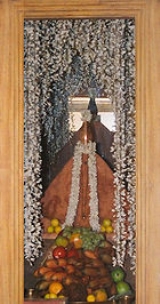
Nizhal Thangal
Encyclopedia
Nizhal Thangal are secondary worship places of the Ayyavazhi
, often smaller in size compared to Pathi
s, built per the instructions of Akilattirattu Ammanai
. Cleanliness is strictly enforced.
Though the common people, mainly in early times call them as Narayanaswami koil or Narayanaswami pathi, the Ayyavazhi scriptures consider these centers distinct from The Pathi
s. They call these worship centers, which were not associated with the religious activities of Vaikundar as 'Inai Thangals'.
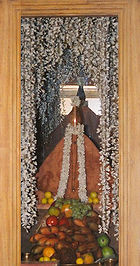 After the trial of Vaikundar with the king of Travancore, the followers built religious centers following his instructions to propagate his teachings which were called as Nizhal Thangal. Akilattirattu Ammanai
After the trial of Vaikundar with the king of Travancore, the followers built religious centers following his instructions to propagate his teachings which were called as Nizhal Thangal. Akilattirattu Ammanai
call this as religious schools. The LMS reports too speak in abundance about these worship centers
Tamil
is the official language of worship, and the object of worship is Lord Narayana with the trinity of Brahma
, Vishnu
, and Shiva
.
Nizhal Thangals in Chettikudiyiruppu, Agastheeswaram
, Paloor, Sundavilai, Vadalivilai, Kadambankulam
and Pambankulam were established during the period of Vaikundar per Akilam. And after a large number of Thangals were established throughout India. There are more than 8000 worship centres throughout India
These Nizhal Thangals formed place in the socio-religious life of the people. All the people were brought together here irrespective of caste distinctions. The mode and formalities of worship were revolutionalised in these centers.
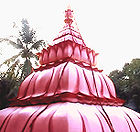 Unlike Pathi
Unlike Pathi
s this Thangals were of small size. Inside the Nizhal Thangals, no murti
or idol
is used. The Palliyarai
of Thangals generally seems similar to Pathis. But inside, in most of the Thangals instead of raised pedestal, chairs were placed as asanas in which the saffron or silk cloths are wrapped-around. A garland made of rudraksha
(string of rudraksha beads) is placed around the neck of the asana
. Mirrors were placed behind. In front of these there will be two standing oil lamps(kuthu vilakku)made of brass, each placed on the either side of the asana.
In some of the Thangals there will be inner corridors as pathis to circumambulate the Palliyarai
. A hall is attached to this palliyarai for the worshippers. In some of the Thangals there are flag masts, Vahana
s and temple car
s etc.
is not an organised religion, thangals are not officially controlled by Swamithoppe, though it was considered as the religious head-quarters. It was considered ritualistic by the Ayyavazhi followers to lay foundation stones for new Thangals by some one from Payyan dynasty
. It seems that the scriptures too give a high status to them in such matters. A survey from the year 2004 states that there are more than 8000 Nizhal Thangals throughout South India
mostly in Tamil Nadu
and Kerala
.
Some Nizhal Thangals serve as community centers, with facilities to cook for large crowds of people; others serve as schools for the community and some as both.
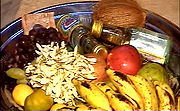 Though the Ayyavazhi
Though the Ayyavazhi
scriptures says about a three-time-worship in common for Nizal Thangals and Pathi
s, most of the Nizhal Thangals use to conduct Panividais (poojas) only twice per day. The three time worship includes Ukappadippu along with Pothippu
at the dawn and at the dusk and the Ucchippadippu in the noon.
But most of the Nizhal Thangals conduct this Ucchippadippu on every Sundays seven times collectively, considering one time per day of a week. On that days Anna Dharmam
(charity on food) is conducted. Some Thangals use conduct this Ucchippadippu on Fridays too. While at few Thangals, which were run by single individuals, the Panividai is conducted only once per day in the evening.
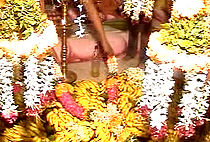 This Thiru Eadu Vasippu, the ritual reading and expatiation of the Holy book Akilam, is an important religious observance of Ayyavazhi. During this days the morning Panivadais are conducted as usual, while in the evening Akilam the scripture of Ayyavazhi is read melodiously by two talented persons and another person use to explain the read verses in a prose form. At the end of every days Anna Dharmam was conducted. This festival was conducted in several Nizhal Thangals for seventeen days (as in Pathis) and the whole content is read-finished. While some other thangals conduct this for three, five, seven, or ten days term reading selected part from the scripture.
This Thiru Eadu Vasippu, the ritual reading and expatiation of the Holy book Akilam, is an important religious observance of Ayyavazhi. During this days the morning Panivadais are conducted as usual, while in the evening Akilam the scripture of Ayyavazhi is read melodiously by two talented persons and another person use to explain the read verses in a prose form. At the end of every days Anna Dharmam was conducted. This festival was conducted in several Nizhal Thangals for seventeen days (as in Pathis) and the whole content is read-finished. While some other thangals conduct this for three, five, seven, or ten days term reading selected part from the scripture.
Some thangals conduct this Thiru-Eadu Vasippu along with the Annual festivals while on some other centers annual festivals are celebrated separately. During that days ' Vahanam Eduppu ' is conducted in which the asanam is carried on Vahanas (vehicles) as processions by the followers.
, the Nizhal Thangals used to conduct one day festival for a grand scale along with Anna Dharmam throughout the day. On the next day 20th of the Tamil month masi, (4 March) all the followers used to visit Panchappathis and so most of the Thangals remain closed while some thangals used to continue the festival as the previous day.
Ayyavazhi
Ayyavazhi is a dharmic belief system that originated in South India in the 19th century. It is cited as an independent monistic religion by several newspapers, government reports and academic researchers. In Indian censuses, however, the majority of its followers declare themselves as Hindus...
, often smaller in size compared to Pathi
Pathi
Pathi is the name of the primary centres of congregational worship for the South Indian religious system of Ayyavazhi, having a relatively large structure like that of a temple...
s, built per the instructions of Akilattirattu Ammanai
Akilattirattu Ammanai
Akilathirattu Ammanai , also called Thiru Edu , is the main religious text of the Tamil belief system Ayyavazhi...
. Cleanliness is strictly enforced.
Though the common people, mainly in early times call them as Narayanaswami koil or Narayanaswami pathi, the Ayyavazhi scriptures consider these centers distinct from The Pathi
Pathi
Pathi is the name of the primary centres of congregational worship for the South Indian religious system of Ayyavazhi, having a relatively large structure like that of a temple...
s. They call these worship centers, which were not associated with the religious activities of Vaikundar as 'Inai Thangals'.
History

Akilattirattu Ammanai
Akilathirattu Ammanai , also called Thiru Edu , is the main religious text of the Tamil belief system Ayyavazhi...
call this as religious schools. The LMS reports too speak in abundance about these worship centers
Tamil
Tamil language
Tamil is a Dravidian language spoken predominantly by Tamil people of the Indian subcontinent. It has official status in the Indian state of Tamil Nadu and in the Indian union territory of Pondicherry. Tamil is also an official language of Sri Lanka and Singapore...
is the official language of worship, and the object of worship is Lord Narayana with the trinity of Brahma
Brahma
Brahma is the Hindu god of creation and one of the Trimurti, the others being Vishnu and Shiva. According to the Brahma Purana, he is the father of Mānu, and from Mānu all human beings are descended. In the Ramayana and the...
, Vishnu
Vishnu
Vishnu is the Supreme god in the Vaishnavite tradition of Hinduism. Smarta followers of Adi Shankara, among others, venerate Vishnu as one of the five primary forms of God....
, and Shiva
Shiva
Shiva is a major Hindu deity, and is the destroyer god or transformer among the Trimurti, the Hindu Trinity of the primary aspects of the divine. God Shiva is a yogi who has notice of everything that happens in the world and is the main aspect of life. Yet one with great power lives a life of a...
.
Nizhal Thangals in Chettikudiyiruppu, Agastheeswaram
Agastheeswaram
Agastheeswaram is a panchayat town in Kanniyakumari district in the Indian state of Tamil Nadu.-Demographics: India census, Agastheeswaram had a population of 8978. Males constitute 49% of the population and females 51%. Agastheeswaram has an average literacy rate of 84%, higher than the national...
, Paloor, Sundavilai, Vadalivilai, Kadambankulam
Kadambankulam
Kadambankulam is a small village in the Radhapuram taluk of Tirunelveli District. It is 7 km from Vallioor. Kadambankulam, a hamlet in the extreme south of Vallioor, covers an area of 30 km2. As the major occupation of the villagers is agriculture, around 60% of the area is covered by...
and Pambankulam were established during the period of Vaikundar per Akilam. And after a large number of Thangals were established throughout India. There are more than 8000 worship centres throughout India
These Nizhal Thangals formed place in the socio-religious life of the people. All the people were brought together here irrespective of caste distinctions. The mode and formalities of worship were revolutionalised in these centers.
Architecture and Structure

Pathi
Pathi is the name of the primary centres of congregational worship for the South Indian religious system of Ayyavazhi, having a relatively large structure like that of a temple...
s this Thangals were of small size. Inside the Nizhal Thangals, no murti
Murti
In Hinduism, a murti , or murthi, or vigraha or pratima typically refers to an image which expresses a Divine Spirit . Meaning literally "embodiment", a murti is a representation of a divinity, made usually of stone, wood, or metal, which serves as a means through which a divinity may be worshiped...
or idol
Cult image
In the practice of religion, a cult image is a human-made object that is venerated for the deity, spirit or daemon that it embodies or represents...
is used. The Palliyarai
Palliyarai
Palliyarai+is a Tamil word used for the Sanctum Sanctoram in Hindu temples. It generally means the place for divine resting and is considered very holy by the Hindus...
of Thangals generally seems similar to Pathis. But inside, in most of the Thangals instead of raised pedestal, chairs were placed as asanas in which the saffron or silk cloths are wrapped-around. A garland made of rudraksha
Rudraksha
Rudraksha Rudraksha Rudraksha (also Rudraksh; Sanskrit: ("Rudra's tears") is a large evergreen broad-leaved tree whose seed is traditionally used for prayer beads in Hinduism. The seed is borne by several species of Elaeocarpus, with E. ganitrus being the principal species used in the making of a...
(string of rudraksha beads) is placed around the neck of the asana
Asana
Asana is a body position, typically associated with the practice of Yoga, originally identified as a mastery of sitting still, with the spine as a conduit of biodynamic union...
. Mirrors were placed behind. In front of these there will be two standing oil lamps(kuthu vilakku)made of brass, each placed on the either side of the asana.
In some of the Thangals there will be inner corridors as pathis to circumambulate the Palliyarai
Palliyarai
Palliyarai+is a Tamil word used for the Sanctum Sanctoram in Hindu temples. It generally means the place for divine resting and is considered very holy by the Hindus...
. A hall is attached to this palliyarai for the worshippers. In some of the Thangals there are flag masts, Vahana
Vahana
Vāhana denotes the being, typically an animal or mythical entity, a particular deva is said to use as a vehicle. In this capacity, the vāhana is often called the deity's mount. Upon the partnership between the deva and his vāhana is woven much iconography and mythology...
s and temple car
Temple car
Temple cars are chariots used to carry representations of Hindu gods. The car is usually used on festival days, when many people pull the cart....
s etc.
Administration
Some of the thangals were built and maintained by single individuals, some by various organisations and some built as town or village-commons. Since AyyavazhiAyyavazhi
Ayyavazhi is a dharmic belief system that originated in South India in the 19th century. It is cited as an independent monistic religion by several newspapers, government reports and academic researchers. In Indian censuses, however, the majority of its followers declare themselves as Hindus...
is not an organised religion, thangals are not officially controlled by Swamithoppe, though it was considered as the religious head-quarters. It was considered ritualistic by the Ayyavazhi followers to lay foundation stones for new Thangals by some one from Payyan dynasty
Payyan dynasty
Payyan dynasty is a family which manage and administer Swamithope pathi, the head quarters of Ayyavazhi. The genesis of Payyan dynasty was a bit uncertain. It was believed to be the descendants of Pothukkutty who was called as Payyan by Ayya Vaikundar...
. It seems that the scriptures too give a high status to them in such matters. A survey from the year 2004 states that there are more than 8000 Nizhal Thangals throughout South India
South India
South India is the area encompassing India's states of Andhra Pradesh, Karnataka, Kerala and Tamil Nadu as well as the union territories of Lakshadweep and Pondicherry, occupying 19.31% of India's area...
mostly in Tamil Nadu
Tamil Nadu
Tamil Nadu is one of the 28 states of India. Its capital and largest city is Chennai. Tamil Nadu lies in the southernmost part of the Indian Peninsula and is bordered by the union territory of Pondicherry, and the states of Kerala, Karnataka, and Andhra Pradesh...
and Kerala
Kerala
or Keralam is an Indian state located on the Malabar coast of south-west India. It was created on 1 November 1956 by the States Reorganisation Act by combining various Malayalam speaking regions....
.
Some Nizhal Thangals serve as community centers, with facilities to cook for large crowds of people; others serve as schools for the community and some as both.
Prayer and Rituals

Ayyavazhi
Ayyavazhi is a dharmic belief system that originated in South India in the 19th century. It is cited as an independent monistic religion by several newspapers, government reports and academic researchers. In Indian censuses, however, the majority of its followers declare themselves as Hindus...
scriptures says about a three-time-worship in common for Nizal Thangals and Pathi
Pathi
Pathi is the name of the primary centres of congregational worship for the South Indian religious system of Ayyavazhi, having a relatively large structure like that of a temple...
s, most of the Nizhal Thangals use to conduct Panividais (poojas) only twice per day. The three time worship includes Ukappadippu along with Pothippu
Pothippu
The Pothippu is one of the sub-sections of Arul Nool which was the secondary scripture of Ayyavazhi.The author of the content is unknown. This is a prayer form called 'Mappu Kettal'....
at the dawn and at the dusk and the Ucchippadippu in the noon.
But most of the Nizhal Thangals conduct this Ucchippadippu on every Sundays seven times collectively, considering one time per day of a week. On that days Anna Dharmam
Anna Dharmam
Anna Dharmam is a term used for an Ayyavazhi ritual that involves sharing food without inter-dining. Inter-dining refers to the act of dining within ones own caste, and excluding others. The practice of Anna Dharmam may have emerged in association with inter-dining.-Origin:Inter-dining was an...
(charity on food) is conducted. Some Thangals use conduct this Ucchippadippu on Fridays too. While at few Thangals, which were run by single individuals, the Panividai is conducted only once per day in the evening.
Pal vaippu
This 'Pai vaippu' is a festival in which the rice boiled in milk and used to serve as grew. At present every worship centers of Ayyavazhi has this practice at least once in a month, while in some other Thangals it was conducted once in a week. During this Pal vaippu cooked rice is also served in addition to this 'Pal' as an action of charity. During this days as ritualistic actions, the 'Periya Ukappadippu' (the extended Ukappadippu), ' Thana Niraivu Vasakam ' and 'Vazappadippu' is also sunged in the evening as additional form of Prayers during this days.Festivals
The main form festival which is conducted in Nizhal Thangals are The Thiru Eadu Vasippu and the Vaikunda Avatharam. The Thiru-Eadu Vasippu was conducted for several days while the Vaikunda Avatharam celebration is mostly for a day of time in Nizhal Thangals. Some Thangals use to conduct Annual festivals too.Thiru-Eadu Vasippu

Some thangals conduct this Thiru-Eadu Vasippu along with the Annual festivals while on some other centers annual festivals are celebrated separately. During that days ' Vahanam Eduppu ' is conducted in which the asanam is carried on Vahanas (vehicles) as processions by the followers.
Vaikunda Avatharam
This was the only festival in Ayyavazhi, which is celebrated at a time throughout all the worship centers across the country. During this festival on 19th masi (March 3) the day before the Ayya Vaikunda AvataramAyya Vaikunda Avataram
The Ayya Vaikunda Avataram is a festival celebrated by the followers of Ayyavazhi on the 20th day of the Tamil Month of Masi, the date on which the Ayyavazhi followers believe that Lord Vaikundar arose from the sea at Thiruchendur as the son of Mummorthies to destroy the evil spirit of Kali and...
, the Nizhal Thangals used to conduct one day festival for a grand scale along with Anna Dharmam throughout the day. On the next day 20th of the Tamil month masi, (4 March) all the followers used to visit Panchappathis and so most of the Thangals remain closed while some thangals used to continue the festival as the previous day.
See also
- List of Ayyavazhi-related articles
- PathiPathiPathi is the name of the primary centres of congregational worship for the South Indian religious system of Ayyavazhi, having a relatively large structure like that of a temple...
- AyyavazhiAyyavazhiAyyavazhi is a dharmic belief system that originated in South India in the 19th century. It is cited as an independent monistic religion by several newspapers, government reports and academic researchers. In Indian censuses, however, the majority of its followers declare themselves as Hindus...

